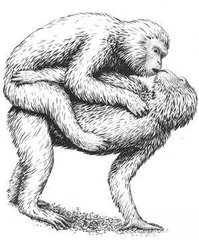When we look at the full range of species and behaviors, we find that male homosexuality is slightly more prevalent, overall, than female homosexuality, although the two are fairly close. Same-sex activity (of all forms) occurs in male mammals and birds in about 80 percent of the species in which homosexuality has been observed, and between females in just over 55 percent of these (the figures add up to more than 100 percent because both male and female homosexuality are found in some species). It must also be kept in mind that the prevalence of female homosexuality may actually be greater than these figures indicate, but has simply not been documented as systematically owing to the general male bias of many biological studies. 19There is also variation between different animal subgroupings: in carnivores, marsupials, waterfowl, and shorebirds, for example, male and female homosexuality are almost equally common (in terms of the number of species in which each is found), while in marine mammals and perching birds male homosexuality is more prevalent. And in many species same-sex activity occurs only among males (e.g., Boto, a freshwater dolphin) or only among females (e.g., Puku, an African antelope).
The frequency of same-sex behavior in males versus females can also be assessed within a given species, and once again, many different patterns are found: in Rhesus Macaques, Hamadryas and Gelada Baboons, and Tasmanian Native Hens, for example, 80—90 percent of all same-sex mounting is between males, while homosexual activity is also more prevalent among male Gray-headed Flying Foxes. 20In other species, female homosexual activity assumes prominence: more than 70 percent of same-sex copulations in Pukeko are between females, and 70—80 percent of homosexual activity in Bonobos is lesbian. Females account for almost two-thirds of same-sex behaviors in Stumptail Macaques and Red Deer, while homosexual activity is also more typical of females in Red-necked Wallabies and Northern Quolls. 21In some species, however, male homosexuality is so predominant that same-sex activity in females is often missed by scientific observers or rarely mentioned (e.g., Giraffes, Blackbuck, Bighorn Sheep), while the reverse is true in other species (e.g., Hanuman Langurs, Herring Gulls, Silver Gulls). In contrast, Pig-tailed Macaque same-sex mounting, Galah pair-bonds, and Pronghorn homosexual interactions are fairly equally distributed between the two sexes (although actual same-sex mounting is more common in male Pronghorns). 22
As with the species of Geese mentioned above, gender differences are also apparent in various behavior types. Of those mammal and bird species in which some form of homosexual behavior occurs, each of the activities of courtship, affectionate, sexual, or pair-bonding are generally more prevalent in male animals. They occur among males in 75—95 percent of the species in which they are found, while among females these activities occur in 50—70 percent of the species (again, however, the possible gender bias of the studies these figures are based on must be kept in mind). The one exception is same-sex parenting, which is performed by females in more than 80 percent of the species where this behavior occurs, but by males in just over half of the species that have some form of such parenting. Of course, not all these forms of same-sex interaction always co-occur in the same species, and animals sometimes differ as to which activities males as opposed to females of the same species tend to participate in (as in the Geese). In Silver and Herring Gulls, for example, females form same-sex pairs that undertake parenting duties while males engage in homosexual mounting; in Cheetahs and Lions, both sexes engage in sexual activity, but males in each species also develop same-sex pair-bonds while female Cheetahs participate in same-sex courtship activities. In Ruffs, males engage in sexual, courtship, and (occasional) pairing activity with each other, while Reeves (the name for females of this sandpiper species) participate primarily in sexual activity with one another.
Within each of the categories of courtship, sexual, pairing, and parenting behaviors, further gender distinctions can be drawn. Consider various types of sexual behavior. Mounting as a same-sex activity is ubiquitous and occurs fairly regularly in both males and females (although there are exceptions—in African Elephants, for example, sexual activity between males assumes the form of mounting while female same-sex interactions consist of mutual masturbation). Oral sex (which includes activities as diverse as fellatio, cunnilingus, genital nuzzling and sniffing, and beak-genital propulsion) is about equally prevalent in both sexes. Group sexual activity is more common in males (only occurring among females in 6 species, including Bonobos and Sage Grouse), as are interactions between adults and adolescents (only occurring among females in 9 species, including Hanuman Langurs, Japanese Macaques, Ring-billed Gulls, and Jackdaws, but among males in more than 70 species). Although penetration is also more typical of male homosexual interactions, there are notable exceptions (e.g., Bonobos, Orang-utans, and Dolphins, as mentioned previously). Gender differences sometimes also manifest themselves in the minutiae of various sexual acts. Same-sex mounting in Gorillas, for instance, is performed in both face-to-face and front-to-back positions, but the two sexes differ in the frequency with which these two positions are used: females prefer the face-to-face position, adopting it in the majority of their sexual interactions, while males use it less often, in only about 17 percent of their homosexual mounting episodes. 23In contrast, the frequency of full genital contact during homosexual copulations is nearly identical for both sexes of Pukeko: females achieve cloacal contact in about 23 percent of their same-sex mounts while males do so in about 25 percent of theirs (in comparison, genital contact occurs in a third to half of all heterosexual mounts). Among Flamingos, though, genital contact is more characteristic of copulations between females than between males. 24
Or consider pair-bonding and parenting. Stable, long-lasting pair-bonds are generally not more characteristic of females (contrary to what one might initially expect); mated pairs or partnerships are almost equally common in both sexes (in terms of number of species in which homosexual pair-bonding occurs), while same-sex companionships are more prevalent between males. Likewise, long-term pair-bonds are just as likely to be found between males as females, while nonmonogamy and divorce occur in male and female couples in roughly equal numbers of species. Nor are male couples less successful parents: male coparents or partners are not overrepresented among the few species in which same-sex parents occasionally experience parenting difficulties. One area where a gender difference in same-sex parenting does manifest itself is in the way that homosexual pairs “acquire” offspring. Particularly among birds, female couples can raise their own offspring by simply having one or both partners mate with males without interrupting their homosexual pair-bond. This option is not as widely available for male couples, who usually father their own offspring by forming a longer-lasting (prior or simultaneous) association with a female (as in Black Swans, Greylag Geese, and Greater Rheas).
Japanese Macaques offer a particularly compelling example of the multiple ways that homosexual activity can differ between males and females. Although homosexual mounting occurs in both sexes in this species, males and females differ in the specific details of their sexual interactions. Homosexual mounts are usually initiated by the mounter between males but by the mountee between females, make use of a wider variety of mounting positions between females, are accompanied by a unique vocalization only between males, and involve pelvic thrusting and multiple mounts more often between females than between males. 25The two sexes also differ in their partner selection and pair-bonding activities: females generally form strongly bonded consortships and have fewer partners than males, while the latter tend to interact sexually with more individuals and develop less intense bonds (although some do have “preferred” male partners). Finally, there is a seasonal difference in male as opposed to female same-sex interactions: homosexual mounting is more common outside the breeding season in males but during the breeding season in females, while same-sex bonds in females, but not males, may extend into yearlong associations that transcend the breeding season.
Читать дальше












